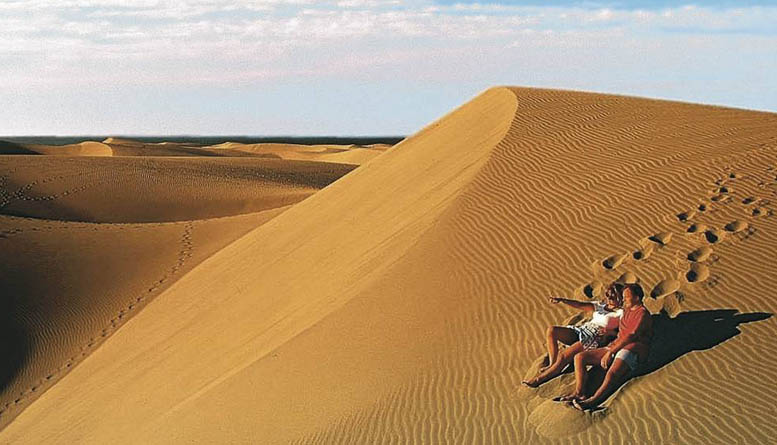 Maspalomas Dunes
Maspalomas Dunes
Between the bustling resorts of the south, a true oasis of peace springs up, although the word "oasis” hardly an appropriate term for 418 ha of beautiful snow-white dunes, which bring to mind the African Sahara. Once upon a time, that they were made of sand blown from over Africa, however, it is now known beyond doubt, that they were formed by limestone sand, crushed shells and corals brought by the sea. The dunes are under protection, which saved them from any buildings. You can walk on the snow-white sand without any restrictions, Furthermore, those willing can take part in a camel ride.
Golf
Two golf courses have been created within the resorts – Maspalomas Oraz Golf Club Meloneras Golf, which, admittedly, are considered relatively simple by golf fans, but apparently good enough for a summer party.
Bicycles
The fascinating curves of the mountain roads attract many mountain bikers to Gran Canaria. If someone feels physically up to it, join the peloton, can take advantage of the Happy Biking offer (Continental hotel) and Free Motion (hotel Sandy Beach), which rent two-wheelers (ok. 10 € per day), but also organize several-hour or full-day bicycle trips (ok. 40 €).
Extreme sports People, who need a little more adrenaline can join the daredevils jumping over the Maspalomas dunes with Skydive. Less extreme, but equally interesting are sea kayaking trips, organized by Canarias Extreme. The company also offers quad safari.
Theme and nature parks
Several parks have been created around Maspalomas, where you can spend a nice afternoon with your children.
To the most visited, also by adults, should be distant by approx. 10 km from Palomitos Park Resort, in which the truest subtropical oasis full of flowers has been created, palm trees and exotic plants. Many animals live in the park – from orangutans, kangaroos and meerkats beginning, by exotic fish floating in an aquarium, and ending with colorful parrots and free-flying toucans. The visit is enriched by bird shows of predatory birds and a merry performance with parrots. Pose , this is where you can see the orchid cultivation and the largest "butterflyarium" in Europe, where hundreds of exotic and fabulously colorful butterflies fly in the wild. In Mundo Aborigen you can learn a little more about the habits of the first inhabitants of the island. A traditional village has been reconstructed in the park, in which over a hundred life-size figures were placed, staging scenes from the life of the Guanches. Western fans will be in their element in Sioux City, a spaghetti-western-style town. The park hosts "traditional" Indian performances and stunt shows with cowboys. Swimming enthusiasts should go to Aqualand, where on over 5 thousand. m2, there are slides and swimming pools with such suggestive names, like Kamikaze or Adrenaline. Camel Park Safari offers camel rides and a small zoo.
Left Well
Driving north along the coast, reaches a distant fr 22 km od Maspalomas Pozo Izquierdo. The beach in this small and rather inconspicuous settlement surrounded by windmills is considered one of the best for windsurfing. The world championships in this spectacular sport are held here every year.
In addition to a few bars, there is an International Windsurfing Center on site (International Windsurf Center), having their own shelter, swimming pool and restaurant.
The Pozo Scuba diving school also operates in the center.
Harbor
Just 18 km north of bustling Maspalomas lies the mountain village of Fataga – completely different world: little whitewashed houses, a modest church, bar and almost a thousand palm trees. About 1,5 km north of the city are welcomed by the rustic hotel and restaurant El Molino del Agua in a 16th century country house. The connection with the world is guaranteed by a bus #38, running on the Maspalomas-San Bartolome de Tirajana route.
San Bartolome de Tirajana and surroundings
From Fataga, the road full of bends leads up a picturesque gorge, up to lying in height 850 m n.p.m. the agricultural village of San Bartolome de Tirajana. It is difficult to point to one noteworthy monument here, maybe outside the church of St.. James – the town is simply a charming traditional mountain village and a good base for hiking in the area. The village is famous for making tinctures on rum, chilli, which you can try in the Martin bar. The charming hotel and restaurant La Hacienda del Molino has recently opened here, where you can see the mill used to make a waffle.
A few kilometers to the south, the green oasis hides not only the small village of Arteara, but also the remains of the largest necropolis of Guanche. The trail through this important and interesting archaeological site starts right next to the bus stop in Arteara, where the bus stops #18.
Santa Lucia de Tirajana and surroundings
East of San Bartolome, another traditional mountain settlement emerges from among the palm trees, Santa Lucia de Tirajana, with an intriguing church resembling Moorish buildings. There is also a 50-year-old in the town… castle, Castle Museum La Fortaleza, built by the eccentric artist Vincente Sanchez Arania, who lived there until his death in 1997 r.
W 16 In the chambers, you can see the items collected by the artist that belonged to the Guanches, weapons and other products. A few kilometers south of Santa Lucia de Tirajana rises the impressive rock formation of La Fortaleza, visible from the GC-65 road., in which the Guanches excavated several dozen residential caves.
Buses to Santa Lucia run rarely – the site is accessible from Aguimes and San Bartolome. There are a dozen or so pubs on the road that runs through the town, of which El Mirador is particularly recommendable, where the wine produced in the surrounding bodega is served.